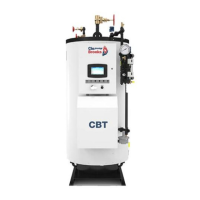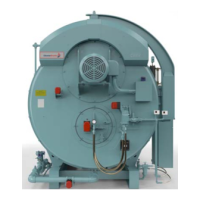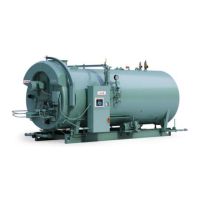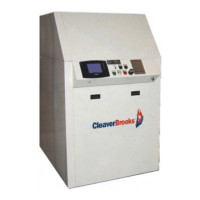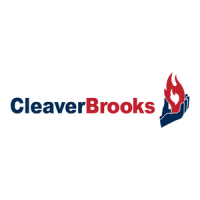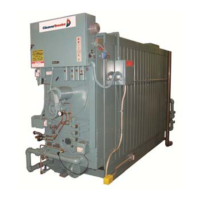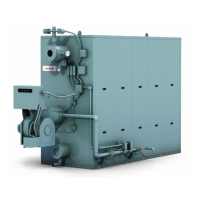750-91 (revised 2009)
Model CB-LE Packaged Boiler Manual
5-9
5.7 — Firing Preparations for Gas (Series 200-400-700)
The electric heater on burners equipped for No. 6 fuel oil is sized so that it is capable of supplying heated oil at
a rate no greater than that required for low fire operation and is primarily supplied for convenience on cold
starts. Heating coils utilizing either steam or hot water are supplied to provide sufficient heat so that higher rates
of firing can be accomplished once steam pressure or hot water is available. In normal operation, the thermostat
governing the electric heating element is kept at a lower setting than the thermostat governing admission of
steam to the heater, or of hot water circulation, so that heating is not performed electrically except when steam
or hot water is not available.
3. Set the steam thermostat or the hot water thermostat to maintain an oil temperature of 220º - 230º F. The elec-
tric heater will be turned off automatically as soon as steam or hot water provides heat.
4. Close the manual bypass valve after the temperature rise on the fuel oil controller thermometer is noted. Be cer-
tain that hot oil is moving through the controller. The orifice gate valve must also be closed. If the temperature
drops, open the orifice gate valve until a rise is noted, then close it.
5. Once the correct setting of the heater thermostats has been established, set the low oil temperature switch at the
point approximately 30º F lower than the normal burning temperature. If the system is equipped with a high oil
temperature switch, it should be set to open at 20º to 30º F higher than normal burning temperature.
5.6.4 — Starting
When all the conditions covered in Sections 5.1, 5.2, 5.3, and 5.4 are assured, the burner is ready for firing. Refer to
Section 5.8 for further starting and operating information.
5.7 — Firing Preparations for Gas (Series 200-400-700)
1. Prior to initial starting, check the linkage attached to the gas butterfly valve to assure that movement is free from
binding.
2. Verify the presence and availability of gas. On a new installation, representatives of the gas utility should be pres-
ent when gas first flows into the system to supervise purging of the new gas line, unless they have already done
so.
3. Determine that the pilot is operating properly, as outlined in Section 5.3.
4. Determine that sufficient pressure exists at the entrance to the gas train by installing a test gauge downstream of
the regulator.
5. The gas pressure regulator must be adjusted to the proper pressure level. Since the regulator is generally sup-
plied by others, adjustment should proceed according to instructions supplied by its manufacturer.
It is necessary for the operator to know the burner requirements in gas quantity and pressure. The information
can generally be found on the Dimension Diagram (DD) supplied by Cleaver-Brooks for the specific installa-
tion. Should the information not be readily available, consult the Cleaver-Brooks Service Department, and be
NOTE: The temperatures listed are tentative. The composition of the fuel oil in a given grade can vary, necessitating a
higher or lower preheating temperature. The viscosity of the oil at the nozzle should be less than 300 SSU and prefera-
bly less than 150 SSU. The actual temperature of the oil at the burner should be determined by flame appearance and
good combustion based on a stack analysis. Review this chapter for additional information.
NOTE: The maximum oil temperature allowed in the system is 250º F.
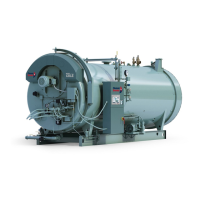
